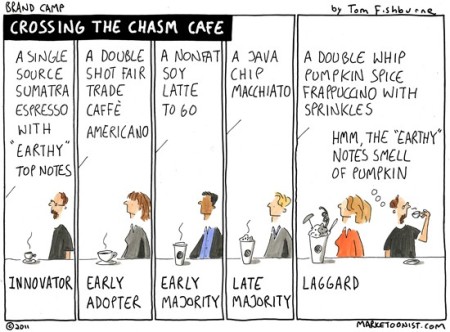
[The thoughts below came to me while listening to “Lecture 3: Creative Styles” of “The Creative Thinker’s Toolkit,” an audio course on Creative Problem Solving by The Great Courses.]
Most people speak about creativity as a gift that nature bestows randomly upon a few select individuals. The truth is: all people are creative to some degree. We “creative types” have simply had more practice. Michael Kirton, Director/Founder of the Occupational Research Center, went one step further, showing that creativity is defined by style, as well as degree. In his book Adaptors and Innovators Kirton describes Adaption-Innovation as a cognitive style, a “preferred mode of tackling problems at all stages.” “Adaptors” are the people who work mostly within established norms, play by the rules, focus on details, and aim at doing things bettter. “Innovators” tend to “detach the problem from its cocoon of accepted thought,” to step “out of the box”, turn things on their head and aim at doing things differently.
Organizations need both types of creativity to succeed. Innovative creativity is most needed when a company is starting out, when it is in a crisis, but also to a more measured degree during the easy times in order to avoid stalling. Adaptive creativity gives new ideas strength and longevity, and is the primary driver of growth in stable and predictable environments.
The lecturer in my Great Course series put forward two great artists as exemplars of the two types of creativity: Norman Rockwell, who strove for idealized perfection, was an “adaptive” creator, while Pablo Picasso, the “bad boy” who challenged the established norms and helped change the way we look at painting, was an “innovator.” (Pop-quiz: where within that spectrum do you think Haydn, Beethoven, Verdi, Puccini, Stravinsky and Britten fall?)
The choice of terms is a little unfortunate, since “innovator” sounds more glamorous than “adaptor.” The fact remains that both Rockwell and Picasso were geniuses. Although history tends to elevate Innovators above Adaptors, we shouldn’t forget that in real time both types are equally indispensable.
The problem is that, since each one of us leans toward one side or the other, we tend to view the guys on the other side with suspicion: Innovators tend to be condescending to Adaptors and see them as stayed and unimaginative. Adaptors see Innovators as undisciplined, inconsiderate and, well, crazy. When an organization is in any kind of crisis, each side sees the other’s approach as the problem.
In my world, the world of regional opera in the US, the tug-of-war between adaptation and innovation plays out in the repertoire discussion. Boheme or Nixon in China? Artists, administrators and patrons are all creative thinkers-even if the “creative” label is typically attached to the artists-and we are all trying to solve one problem: attendance. Adaptors insist that the established norm, traditional repertoire, is the solution, if only we can improve, optimize and repackage it. Innovators think that shaking things up with new, unfamiliar, ground-breaking programming is the way to go.
The truth is somewhere in between.
Our operating environment, contemporary American culture, society and economy, is volatile. The performing arts are not an automatic draw. “Business as usual” is not working. It’s time for innovation, so Adaptors have to suspend judgement and give the bad boys and girls a chance. They should also put their own irreplaceable ability to improve, perfect and proliferate at the service of new ideas. Innovators have to be patient. This is not a “go big or go home” time, nor should we throw the baby out with the bath water. Nourishment comes from the roots, and unless they get the Adaptors to work with them, their fancy new ideas will be short-lived.
It’s time to learn how to talk to each other.
Leave a Reply